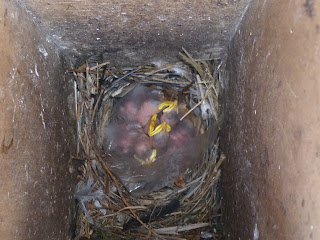Over the weekend, and yesterday, I paid my first visit of 2017 to monitor the nestboxes at Linacre. I had a feeling they'd be further on than last year, as I'd seen 1
Blue Tit entering a box last weekend. As it turned out, I found a total of 29 boxes with nests in them ranging from N1 to NL, and even 1 with an egg!! The egg is particularly early, with the first one in 2016 not recorded until 5th May!
Nest with an egg (possibly Blue Tit)
On Sunday I checked 4 of the 5 "owl" boxes that I have up around the site. The
Little Owl box was empty, as were 3 of the other boxes. The remaining box contained.... a
Grey Squirrel nest complete with 2 young squirrels. Last year, two of the owl boxes were used by
Mandarin Ducks, but eggs weren't laid until later in the month, so I'll pop back in a couple of weeks to see if anything's happened. All the results will be sent in to the
BTO's Nest Record Scheme.
After checking the boxes I walked around the site to carry out this month's
WeBS walk. Numbers were quite low, but the following were spotted:
Mallard (27),
Tufted Duck (27),
Coot (7 - including the first nest of 2017 on the top reservoir),
Moorhen (3),
Mandarin (11),
Cormorant (3; 2 adults, including one with a ring, and an immature bird),
Great-crested Grebe (3),
Mandarin Duck (11) and
Grey Wagtail (1).
Mandarin Duck
Other birds seen included a
Mistle Thrush carrying food to an unseen nest, 3
Sand Martins, 1
Swallow (first Linacre records of 2017), a minimum of 3 singing
Willow Warblers, 5 singing
Blackcaps and 4 singing
Chiffchaffs.
Siskins and
Lesser Redpoll were also heard.
It was quite sunny yesterday morning, so there were a few insects flying around, including a single
Peacock, several
Droneflies (Eristalsis sp), and, best of all, a potential new species;
Early Mining Bee.
Early Mining Bee??
Year List update:
122 - Swallow








































